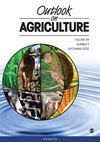Beef cattle production systems and constraints among subsistence farmers across the Fijian windward–leeward divide
IF 2.6
3区 经济学
Q1 AGRICULTURE, MULTIDISCIPLINARY
引用次数: 0
Abstract
The objective of the study was to describe beef production systems and constraints among subsistence farmers across the Fijian windward–leeward divide. Data were collected from a total of 200 beef cattle owners from windward and leeward locations (100 each) using a structured questionnaire. In both geographical regions, the heads of the households were mostly males and married. Cattle were ranked as the most important species of livestock kept in both leeward and windward areas. In both leeward and windward locations, cattle were mainly kept as a source of income and draught power. Challenges to cattle production differed with the production environment. The major challenges faced by cattle farmers in leeward locations were drought and pasture shortage while farmers in windward locations mainly had theft and disease cases. The odds ratio of Hindu farmers practicing tethering as a grazing method was five times higher than Christian farmers (p < 0.05). Farmers with medium pieces of land were 14 times more likely to use paddocks for grazing their cattle than those with small pieces of land (p < 0.05). Farmers in both leeward and windward locations mostly kept non-descript cattle breeds (>60%) and did not control mating. It was concluded that challenges faced by farmers differed with the production environment but feeding and breeding practices were the same across windward and leeward management locations.斐济逆风-背风分水岭上的肉牛生产系统和自给农民的制约因素
该研究的目的是描述斐济逆风-背风分水岭上自给农民的牛肉生产系统和制约因素。数据是使用结构化问卷从来自向风和背风地区的200名肉牛主(各100名)那里收集的。在这两个地理区域,户主大多是已婚男性。牛被列为背风和向风地区饲养的最重要的牲畜物种。在背风和向风的地方,养牛主要是作为收入和风力的来源。畜牧业面临的挑战因生产环境而异。背风地区养牛户面临的主要挑战是干旱和牧场短缺,而背风地区的养牛户主要有盗窃和疾病病例。印度教农民采用系绳放牧的几率是基督教农民的五倍(p 60%),不控制交配。得出的结论是,农民面临的挑战因生产环境而异,但不同的迎风和背风管理地点的饲养和繁殖做法是相同的。
本文章由计算机程序翻译,如有差异,请以英文原文为准。
求助全文
约1分钟内获得全文
求助全文
来源期刊

Outlook on Agriculture
农林科学-农业综合
CiteScore
5.60
自引率
13.30%
发文量
38
审稿时长
>36 weeks
期刊介绍:
Outlook on Agriculture is a peer reviewed journal, published quarterly, which welcomes original research papers, research notes, invited reviews and commentary for an international and interdisciplinary readership. Special attention is paid to agricultural policy, international trade in the agricultural sector, strategic developments in food production, the links between agricultural systems and food security, the role of agriculture in social and economic development, agriculture in developing countries and environmental issues, including natural resources for agriculture and climate impacts.
 求助内容:
求助内容: 应助结果提醒方式:
应助结果提醒方式:


